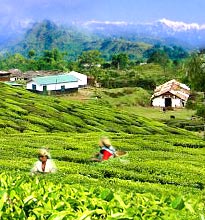 The ancient town of Hajo is one of the most interesting places in the state of Assam, situated on the banks of river Brahmaputra, around 24 km from the city of Guwahati. What makes Hajo an important tourist destination is that this is the only place in the state where there is a confluence of three major religions of the world - Hinduism, Islam and Buddhism. Shrines dedicated to Durga, Shiva, Vishnu, Buddha and major Muslim saints are found all over this place, making it an important pilgrimage center for people from all these three religions.
The ancient town of Hajo is one of the most interesting places in the state of Assam, situated on the banks of river Brahmaputra, around 24 km from the city of Guwahati. What makes Hajo an important tourist destination is that this is the only place in the state where there is a confluence of three major religions of the world - Hinduism, Islam and Buddhism. Shrines dedicated to Durga, Shiva, Vishnu, Buddha and major Muslim saints are found all over this place, making it an important pilgrimage center for people from all these three religions.The history of the quiet and peaceful Hajo town is quite interesting. It is said that this town was once the capital of the Koch Dynasty, established by Raghudev, the son of legendary Koch hero Chilarai and nephew of the Kochbehar king, Narayana. The vast Koch Kingdom included Goalpara, North Kamrup, a portion of the former Darrang district and also the present day Mangaldoi subdivision. However, the dynasty came under the occupancy of the Mughals from 1639 to 1658.
With the changing history, different names came to be associated with this region. Hajo was known as Apurnabhava and Manikuta in the 11th century A.D, while the 14th century had its name as Bhisnupuskar (as described in the Yoginitantra). During the 18th century, Hajo came to be known as Manikutgram, as found in the Darang Rangbonshabali by one Surjyakhari Daivajna. During the Mughal reign, the region was called Sujabad or Sujanagar. Some people link the place with ‘haj’, which is the most revered pilgrimage spot of the Muslim community in Mecca.
Scholars and followers of Buddhism have different opinions regarding the origin of the name Hajo. Some believe that Gautam Buddha died in this region and his death pained his disciples so much that they cried out aloud ‘Ha- ju’, which means 'setting of the sun' and thus the place came to be known as Hajo. However, Dr. Banikanta Kakati (a prominent scholar of Assam) believes that there is a Bodo connection to Hajo. He suspects that Hajo is a Bodo name (Ha means land and Gojou means high, according to Bodo dialect).
Hayagriva Madhava Temple
Around 30 km to west of Guwahati, in the town of Hajo, is situated one of the most sacred pilgrimage spot in Assam - Hayagriva Madhava Temple. Highly revered by the Hindus as well as the Buddhists, the temple enshrines an image of Lord Vishnu, which resembles the image of Lord Jagannath at Puri (Orissa).
How to Reach Hajo
Reaching Hajo is quite easy, as there is a good connectivity to this place from the nearby cities, like Guwahati, Tezpur etc. The town is located at a distance of about 25 km to the west of Guwahati and is frequently visited by travelers and tourists from all over the globe.
Powa Mecca
Standing atop the Garurachal Hill, just adjacent to the Madhava Temple, is the much renowned shrine of the Muslims - Powa Mecca (1/4th Mecca). The most famous Muslim pilgrimage spot in Assam, it noted as the tomb of Pir Giasuddin Auliya, who was the pioneer of Islam in this part of the world.
Hajo Tourist Attractions
The historic town of Hajo serves as the merging point of the three major religions of the world, namely Hinduism, Islam, and Buddhism. Being an important pilgrimage site for all these three religions, Hajo is frequently visited by travelers and tourists all round the year.
Hajo Weather
Like the rest of Assam, the township of Hajo enjoys a ‘tropical monsoon’ type of climate, which is associated with high levels of humidity. The weather is usually moderate all round the year, except for the mild increase in the temperature during the summer season.











